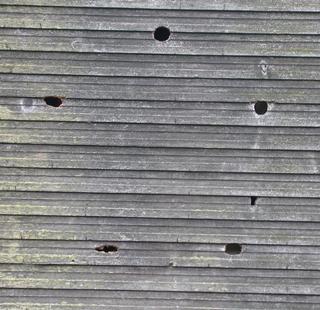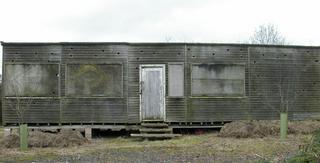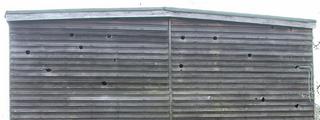


Worcestershire Record No. 20 April 2007 p. 27
Harry Green
While visiting the Community Orchard at Cleeve Prior during the winter 2005-2006 I was astonished to see a wooden shed perforated with woodpecker holes. The shed measures 12x6 m and is about 4 m high and is constructed of thin boarding. It is unlined and (I am told) about 15 years old. During the last five years it has been repeatedly attacked by Green Woodpeckers and there are now 96 holes in the side walls, well-distributed round the whole shed. Each hole is 2-3 inches in diameter. There is no sign of infestation of the wood with wood boring insects.
I could find no explanation for this behaviour. On a very much smaller scale I have been told of a house at Elmley Castle with wooden walls where the owners were driven nuts by a woodpecker hacking away at the upper part of one wall and eventually drilling a hole through the upper side wall into the rood space.
Being somewhat stumped for an explanation of this behaviour and finding the textbooks unhelpful I consulted an old friend - Ken Smith, woodpecker expert at the RSPB and he replied as follows:
A few thoughts on the amazing holes in the shed.
Judging by the size of the door frame they look big enough to be green woodpecker. The perfect round shape implies to me that the bird is trying to excavate a roost or nest hole. Green Woodpeckers would be unlikely to attack dead wood for feeding anyway, but a great spot woodpecker would destroy large areas if it was feeding and would not make a perfect round hole.
I came across something similar years ago with green woodpeckers attacking beehives*. It seemed then that they were after the bees for food because the excavations were very rough - not the perfect holes.
I was consulted years ago about the shingles on a church in the Chilterns being attacked by a green woodpecker but I heard no more about it.
Similarly there was a big issue about ten years ago of woodpeckers attacking some ancient wooden churches in Romania - the churches were ancient monuments so there was a big problem for a while. In this case the culprit was thought to be black woodpecker.
I am very interested in how this develops.
* In Worcestershire there was a similar outbreak of Green Woodpeckers attacking bee-hives at Wilden Marsh Reserve, near Kidderminster.
If anyone has similar records or reports I should be very pleased to hear from you. Meanwhile we shall monitor the shed!
 |
 |
| Front of the shed | |
 |
|
| In one part of the shed wall the holes have formed a pentagon - this may, of course, have considerable mystical significance related to crop circles. | Upper part of one end of shed
|
| WBRC Home | Worcs Record Listing by Issue | Worcs Record Listing by Subject |